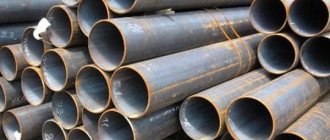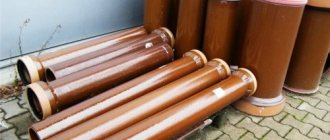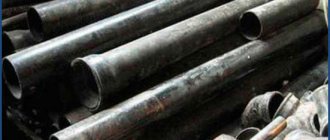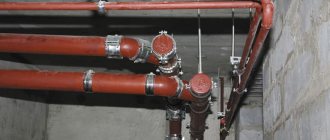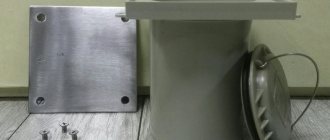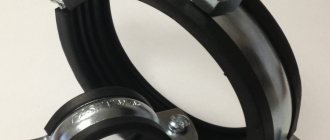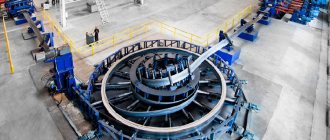Menu
Pipe service life:
- Cast iron sewer
- PVC sewer and water supply
- Ceramic
- Plastic
- Polypropylene
- Metal-plastic
- How to extend the service life of pipes made from these materials
- Video
During the construction of any facility, pipelines are installed in parallel. These necessary durable structures are made of cast iron, plastic, polypropylene, iron and other materials.
The service life of such pipes is equally influenced by the physical and chemical properties of the substances from which they are made, as well as the chemical activity of the medium transported by the pipeline.
In addition, the service life is affected by the temperature characteristics of the pipeline’s internal media, as well as the weather conditions in which the system operates.
Cast iron sewer
What is the service life of cast iron sewer pipes and what does it depend on?
According to the manufacturer's data, the service life of cast iron sewer pipes in private or apartment buildings is about 50-70 years. Although, if you use international experience, such systems can function successfully for 100 or even 200 years! Unbelievable but true!
The service life is affected by the placement conditions of the highway. It is known that sewer systems can be installed both outside and inside the apartment. In this regard, the service life of cast iron sewer pipes in the ground, for example, is significantly less than in a dry room.
Very important: the service life is significantly influenced by the quality of the connections made. The thing is that if the pipeline elements are not connected very well, then the transported medium begins to flow at the joints, which in turn contributes to an accelerated corrosion process.
In general, cast iron products can be considered the most durable of all currently known analogues from other materials. Although, according to GOST 6942-98, the warranty period is only 2 years from the moment the pipeline is put into operation.
Thus, although cast iron sewer systems are becoming increasingly rare today, they have been and remain one of the most durable. According to the results of numerous surveys, many prefer sewer pipes made of alternative materials, based on financial considerations: the cost of cast iron is too high compared, for example, with plastic.
What extends the service life of cast iron pipes
Please note that the installation of communications from cast iron pipes should only be carried out by professionals, that is, people with a good reputation and sufficient work experience.
When using drainage systems from the inside, build-ups may form on the pipes over time, sometimes completely blocking the channel lumen. The only way out of this situation is to flush the sewer system.
If you need to perform scheduled or urgent repairs on a cast iron pipe, it is not at all necessary to change it. You can place a rubber seal on the damaged area and press it with a piece of metal. A clamp is installed on top of it, which is pressed tightly against the metal plate. The clamp can be steel wire or a metal strip secured with bolts. This approach will increase the service life of the sewer system and not violate its tightness.
PVC sewer and water supply
When the building materials market began to fill with plastic products, the share of the use of such pipes in the construction of pipelines increased significantly. Most often, PVC pipes are used in domestic conditions when arranging apartments and private houses. With their help, heating, sewer, and ventilation lines are laid. Therefore, potential buyers always want to know the service life of plastic systems, what it depends on, and how the service life of PVC pipes can be increased.
According to manufacturers' advertisements, sewer pipes can be successfully operated for about 50 years.
Although, not everything is so simple, since this indicator is determined by several factors:
- type of plastic;
- environmental conditions;
- pressure in the system;
- temperature of the internal environment.
PVC products are different:
- safety, lack of toxicity;
- practicality when installing the highway;
- light weight;
- long service life without clogging;
- complete neutrality to corrosion and aggressive environments;
- resistance to living microorganisms.
PVC products are often used for the installation of cold and hot water supply lines, since they are able to withstand water temperatures within +90°C. A water supply system made from PVC pipes will last much longer than a sewer system. The service life of such PVC pipes will be approximately 50 years. Some experts even call the figure 100 years for the operation of PVC water pipelines.
Ceramic
Even the ancient Romans used baked clay to produce ceramic pipes, from which they built systems for draining rainwater and domestic wastewater. Today, ceramic products have successfully competed with cast iron and plastic. According to research results, these materials are less durable than ceramics.
Ceramic pipes are characterized by:
- minimum roughness of the internal (working) cavity. Thanks to this quality, a high flow rate is ensured, which eliminates the possibility of retention of various types of sediment on the walls of the system;
- high mechanical strength;
- resistance to sudden temperature changes;
- chemical inertness. Thanks to a special glaze covering the internal and external surfaces, special joint designs, and sealing materials, not only abrasive wear is completely eliminated, but also the impact of alkaline and acidic environments (pH level = 0-14);
- high environmental friendliness, which is expressed in reliable protection of the contents of the sewerage system from contact with the environment.
For ceramic products, the service life has virtually no restrictions.
What affects the lifespan of a sewer?
If you want the system to last longer, you need to make sure that only high-quality materials are used during installation.
When choosing a pipe, it is important to check the following:
- The external and internal diameter of the pipes must strictly comply with the requirements established by GOST;
- There should be no unnecessary depressions or growths on the surface of the pipes;
- Pipes must be pre-treated with petroleum bitumen;
- Sometimes it is worth considering using special cast iron to protect the coating;
- Check the anti-corrosion coating. Its surface should not have repeated inclusions. Fistulas and sutures should not be visible;
- A fine-grained structure should be observed at breaks and turns.
Internal defects in pipes are much more difficult to find, but experienced craftsmen can determine the presence and location of damage by the sound of tapping the pipe with a metal object. If there are defects, the sound of the blow will differ in duration and tone from the same taps on products that do not contain defects.
Attention - elements for laying systems!
There are many different elements that are used to lay sewer lines. These are various adapters, branching crosses, plugs, fittings, etc. It must be remembered that it is not enough to choose the right pipe itself; it is important to pay special attention to the material of these elements. All materials must be compatible with cast iron. If the material is not selected correctly, the geometry of connections and pipes may change during temperature changes. The pipe material must be free of slag, sagging and foreign growths. The slightest non-compliance with the standard can lead to rapid failure of not only individual elements, but also the entire system at the initial stage of use.
Plastic
When purchasing plastic pipes, the first question that arises from the buyer may be: “What is the service life of such products, what advantages do they have?” In addition, the potential client is interested in the scope of application, the main operating and linear parameters of the pipes.
Plastic pipes differ:
- increased resistance to corrosion processes. Therefore, they are not afraid of moisture, they do not rust or rot, which is very important when using products in heating systems and water supply systems;
- environmentally friendly, since they do not contain chemically hazardous and harmful substances;
- low thermal conductivity coefficient, which contributes to long-term heat retention, which cannot be said about metal products;
- high resistance to sudden changes in temperature and pressure;
- complete absence of noise during water flow inside. Thanks to the internal smooth surface, the possibility of limescale and other mineral deposits is eliminated;
- lightness, which is very convenient for loading, transportation, installation;
- ease of installation, connections in which are made by soldering;
- external neatness and aesthetics;
- low cost, which is important for many consumers.
They are used for installation of water supply systems, sewerage systems, and horizontal wiring of heating systems.
In advertising materials you can read that plastic pipes can function at temperatures up to +95°C and a pressure of 100 kPa. The service life is 50 years or more.
Areas of use
In houses and apartments, cast iron pipes can be used to install a drainage system from sinks, sinks, bathtubs (in the kitchen and bathroom), plumbing fixtures, with subsequent connection to a general sewer system. In apartment buildings, cast iron pipes are used as common risers.
General utilities, hot and cold water supply, are also installed using cast iron pipes. This is due to the proven technology for laying communications, both on the surface (open type) and underground. Resistance to prolonged exposure to low and high temperatures, the ability to withstand sudden changes in temperature without losing the intended operational technical parameters. Ability to withstand possible pressure drops during operation. All these indicators determine the choice of design, construction and operating organizations in favor of cast iron pipes.
Sewage, water supply, heating in private and apartment buildings, made using cast iron pipes, rarely require repair or replacement due to their destruction. The main causes of emergency situations are violations in connection nodes. Sewerage is performed by sequentially joining pipes using a socket, followed by sealing the joints.
The service life of cast iron pipes according to GOST is much higher than the maximum service life of the sealants used, therefore, the main repair work is not related to the replacement of pipes, but to restoring the sealing of the joints.
Heating and water supply systems are connected using fittings made from various materials. The difference in the technical characteristics of the metals at the joints leads to a violation of the tightness of the system.
Menu
During the construction of any facility, pipelines are installed in parallel. These necessary durable structures are made of cast iron, plastic, polypropylene, iron and other materials.
The service life of such pipes is equally influenced by the physical and chemical properties of the substances from which they are made, as well as the chemical activity of the medium transported by the pipeline.
In addition, the service life is affected by the temperature characteristics of the pipeline’s internal media, as well as the weather conditions in which the system operates.
Polypropylene
Why do many people prefer polypropylene pipes?
The answer is simply simple:
- they are not affected by corrosion;
- they are chemically passive to working fluids and gases;
- are distinguished by ease of connections into a single pipeline;
- They have a huge range of locking and connecting fittings.
If necessary, they can be easily repaired, replaced, or inserted into another highway.
The products do not need to be painted, since they already look quite aesthetically pleasing.
Important: they have a low coefficient of thermal expansion, which guarantees long-term heat conservation. This property is essential when using polypropylene products in heating systems.
Water supply, automatic fire extinguishing systems, structures for supplying air and other gases, irrigation systems in agriculture, heating networks - this is not a complete list of applications for polypropylene pipes.
The service life of polypropylene pipes depends on:
- temperature indicators of the carrier;
- working pressure;
- the quality of the source material from which the pipes are made;
- on the operating conditions of the collector and mounted components.
There is a special table of the service life of polypropylene pipes, which indicates the dependence of operating terms on the maximum values of pressure and temperature of the medium:
| Operational life, years | Operating temperature, ⁰ C | MAX pressure, kgf/cm² | ||
| PN 10 | PN 20 | PN 25 | ||
| 10 | 22 | 13,5 | 21,7 | 33,8 |
| 25 | 13,2 | 26,4 | 33,0 | |
| 50 | 12,8 | 25,7 | 32,4 | |
| 10 | 50 | 13,9 | 23,6 | 21,7 |
| 25 | 8,1 | 16,1 | 20,0 | |
| 50 | 7,3 | 14.7 | 18,4 | |
| 10 | 72 | 5,3 | 10,7 | 13,3 |
| 25 | 4,5 | 9,1 | 11,9 | |
| 50 | 4,3 | 8.5 | 10,8 | |
Dimensions
The size is classified by internal diameter: standard parameters vary from 50 to 110 mm. For example, the marking DN 100 means that the internal diameter is 100 mm and the external diameter is 110 mm. Standardized markings for cast iron pipes – from DN 50 to DN 400.
Cast iron pipelines for sewer lines have a length from 750 mm to 2200 mm. Pipes without expansion, with polished ends, have increased strength and are manufactured in lengths of 3 m; detachable options can be from 15 cm or more.
The wall thickness of cast iron pipes is practically no different from plastic options and is 4-5 millimeters. But the weight of metal and plastic structures differs significantly: 1 meter of cast iron pipe with a diameter of 100 mm weighs 14 kg, and plastic equipment with the same parameters weighs about 1.5 kg.
Standardized sizes of cast iron pipes:
- nominal diameter: 50 mm; 100 mm; 200 mm; 260 mm; 350 mm; 600 mm; 800 mm; 1000 mm;
- outer diameter (mm): 81; 118; 274; 378; 635; 842; 1048;
- wall thickness (mm): 7.4; 8.3; 11.0; 12.8; 17.4; 21.1; 24.8;
- length (mm): 750; 1000; 1250; 2000; 2100; 2200.
Metal-plastic
Metal-plastic pipes do not have many of the disadvantages that are typical for products made of pure metal or plastic. The structure of such a pipe is quite simple: the aluminum layer is covered from the inside and on top with layers of polymer origin.
The service life of metal-plastic collectors is significantly affected by:
- ultraviolet radiation;
- working pressure value;
- installation method;
- temperature constancy. This means that you cannot first run hot water through the same pipe and then immediately run cold water. Such a procedure, if it becomes regular, can lead to delamination of the pipe, since aluminum and plastic have different thermal expansion coefficients.
It must be remembered that the optimal temperature regime for such collectors is +10⁰С.
If you adhere to these conditions, then metal-plastic collectors can last up to 40-50 years.
How to fix a leak in a pipe
Repairs can be carried out without draining the water by temporarily reducing the pressure. To do this, they use welding or soldering joints, installing clamps and bandages, and also use chemical compounds - sealants, adhesives, cold welding.
Sometimes owners have to find a way to fix a leak in a heating pipe without welding. After all, while you are filling out an application, a sufficient amount of time passes. And a small hole, when coolant enters under pressure, can quickly turn into a large one and cause significant material damage.
